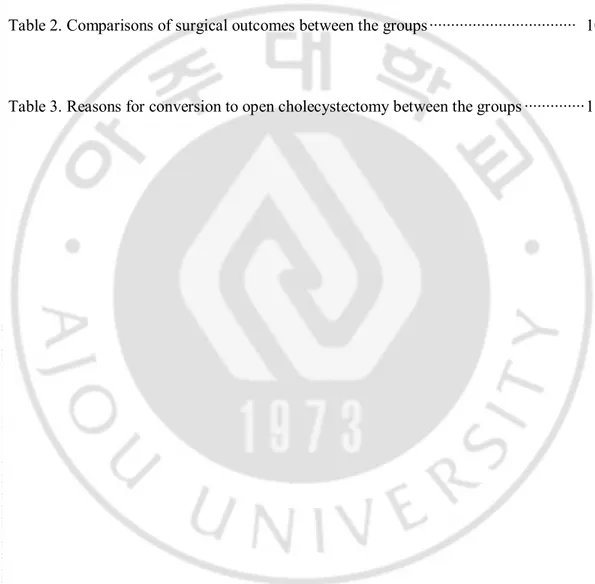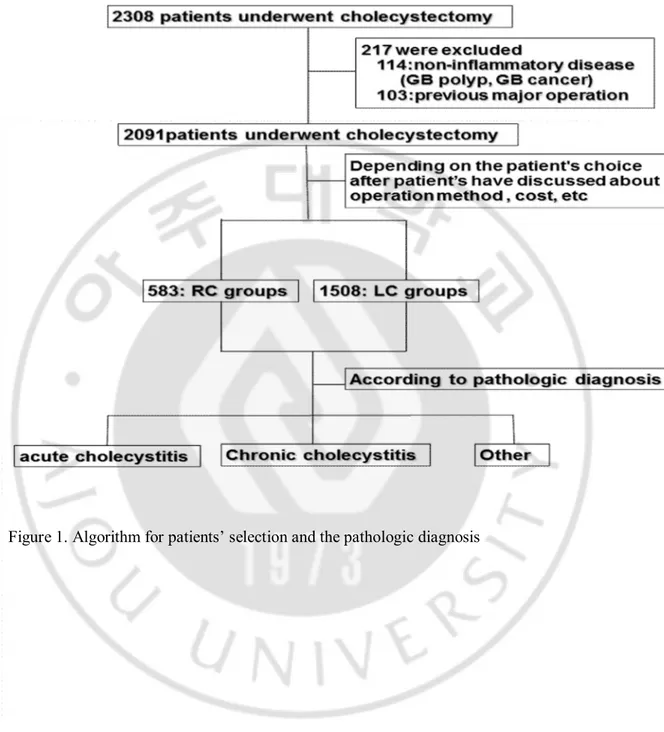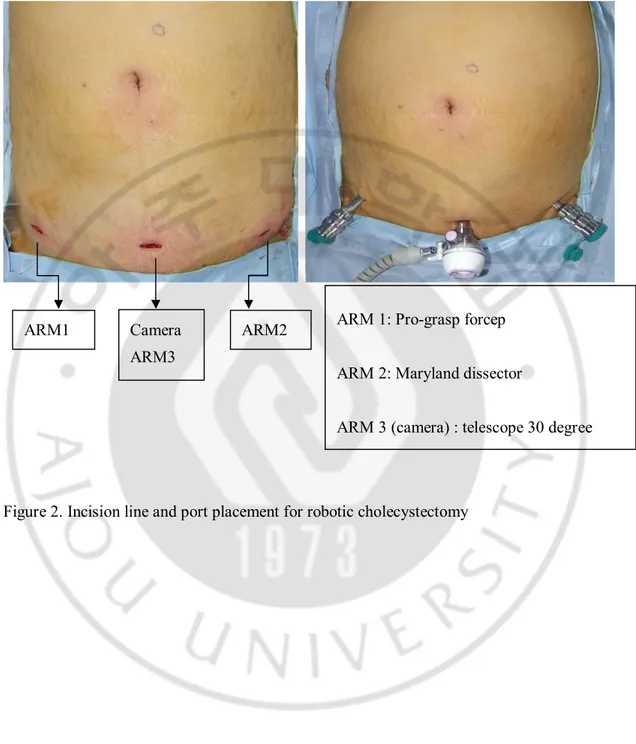Robotic Cholecystectomy versus Laparoscopic
Cholecystectomy
single institution experience in Korea
by
Guang Yi Li
Major in Medicine
Department of Medical Sciences
The Graduate School, Ajou University
Robotic Cholecystectomy versus Laparoscopic
Cholecystectomy
single institution experience in Korea
by
Guang Yi Li
A Dissertation Submitted to The Graduate School of
Ajou University in Partial Fulfillment of the Requirements
for the Degree of
Doctor of Medicine
Supervised by
Wook Hwan Kim, M.D., Ph.D.
Major in Medicine
Department of Medical Sciences
The Graduate School, Ajou University
This certifies that the dissertation
of Guang Yi Li is approved.
SUPERVISORY COMMITTEE
Byung Moo Yoo
Wook Hwan Kim
Ji Hun Kim
Hee-Joon Kang
Jin Seok Heo
The Graduate School, Ajou University
December, 23rd, 2014
i
- ABSTRACT -
Robotic Cholecystectomy versus Laparoscopic Cholecystectomy :
Single institution experience in Korea
To evaluate surgical benefits of robotic gallbladder surgery with new port sites using the da Vinci system by comparing the surgical outcomes of robotic and conventional laparoscopic cholecystectomy in inflammatory gallbladder disease patients. Recently, the robotic cholecystectomy has become an attempt at multiple hospitals, but controversy persisted over use of this approach in the treatment of inflammatory gallbladder disease. We undertook a comparison of the safety and outcome of robotic cholecystectomy (RC) and laparoscopic cholecystectomy (LC) in patients with inflammatory gallbladder disease. From June 2010 to March 2013 at Ajou University Medical Center in Korea, 2091 patients who underwent cholecystectomy due to the inflammation were selected. Of these patients, 583 underwent a robotic procedure using new port sites (RC group), and 1508 a conventional laparoscopic procedure (LC group). The patients were allocated into a robotic cholecystectomy (RC) group and laparoscopic cholecystectomy (LC) group, and these 2 groups were compared in terms of their clinical characteristics and surgical outcomes. There were no statistical differences between the groups in diagnosis, and laboratory findings on admission (P > 0.05). The total operation time for the RC (51.5 ± 19.6 min) was significantly longer than for the LC (42.5 ± 22.3 min; P < 0.05). Postoperative hospitalization and total hospitalization was significantly shorter after RC (1.24 ± 0.85 and 2.9 ± 1.9 days, respectively) compared with LC (1.70 ± 2.4 and 4.1 ± 5.3 days, respectively;
ii
p < 0.05). Complications occurred in 3 of the 583 patients (0.51 %) after RC and 31 of the 1508 patients (2.05 %) after LC. Conversion to open occurred in 2 patient after RC (0.34 %) and 21 patients after LC (1.39 %). These results were significant (p < 0.05 for both). This 2091 patients study confirms that RC in inflammatory gallbladder disease can be performed safely in term of complication and conversion of RC comparable to these for LC. Our findings indicated that RC could be available to all patients requiring cholecystectomy.
Key words: Cholecystitis, Complication, Conversion to open Cholecystectomy, Robotic Cholecystectomy, Laparoscopic Cholecystectomy
iii
TABLE OF CONTENTS
ABSTRACT ··· ⅰ
TABLE OF CONTENTS ··· iii
LIST OF FIGURES ··· iv
LIST OF TABLES ··· v
Ⅰ. INTRODUCTION ··· 1
Ⅱ. PATIENTS AND METHODS ··· 3
Ⅲ. RESULTS ··· 7 A. CLINICAL FINDING ··· 7 B. SURGICAL OUTCOMES ··· 9 Ⅳ. DISCUSSION ··· 12 REFERENCES ··· 16 국문요약 ··· 19
iv
LIST OF FIGURES
Fig. 1. Algorithm for patients selection and the pathologic diagnosis ··· 5
v
LIST OF TABLES
Table 1. Clinical characteristics between the groups ··· 8
Table 2. Comparisons of surgical outcomes between the groups ··· 10
1
-I. INTRODUCTION
Laparoscopic surgery has long been the standard treatment method for gallbladder benign disease (Wiseman et al., 2010). Although conventional laparoscopic surgery has advantages in that it is well-developed technology, affordable, ubiquitous, and has proven efficacy, the approach is limited by a loss of dexterity, haptic feedback, natural hand-eye coordination (fulcrum effect), and movement based on a two-dimensional video monitor which are all somewhat counterintuitive (Kang CM et al., 2007). Also, most laparoscopic operations are difficult to learn, master, and perform routinely, and surgeons face a long learning period (Voitk et al., 2001).
Development of novel surgical methods has aimed to overcome these limitations. The development of a robotic system has enabled delicate and complex operations because the robotic system features sophisticated hand control and can produce a zoomed image of three-dimensional (3-D) motion (Dakin and Gagner, 2003; Jourdan et al., 2004). Many surgeons have used the da Vinci system in surgeries including cholecystectomy, gastrectomy, and thyroidectomy (Ortiz et al., 2010; Ng et al., 2009; Giulianotti et al., 2003; Lee et al., 2011; Woo et al., 2011). Robotic cholecystectomy (RC) was first implemented in 1997. The intervening years have established the safety and feasibility of robotic cholecystectomy, but the surgical benefits remain debatable in the treatment of inflammatory gallbladder disease (Komprat et al., 2006; Breitenstein et al., 2008; Nio et al., 2004; Hanisch et al., 2001).
Since approval of RC by the Korean Food and Drug Administration in 2005, the technique has not been adopted for use in hepato-biliary surgery. This is dues to the absence of compelling surgical benefits for patients in comparison with laparoscopic cholecystectomy.
2
-Although the first RC procedure was been performed in 2005 in Korea, there have not been subsequent procedures at other hospitals in Korea (Kang CM et al., 2007).
The da Vinci system robotic system was introduced in our institution in 2008. We performed the first fully robotic procedure in a patient diagnosed with inflammatory gallbladder diseases in 2010.
We undertook the present large study with the aim of comparing the safety and surgical outcome of RC using new port sites and laparoscopic cholecystectomy (LC) in the treatment of inflammatory gallbladder disease during the same period in a single institution (Kim et al., 2013).
3
-II. PATIENTS AND METHODS
The study was conducted at Ajou University Medical Center. The study retrospectively reviewed the medical records of all patients and analyzed data including clinical information, operation records, and pathologic diagnoses of 2308 patients who underwent cholecystectomy from January 2011 to June 2013. Of these patients, we selected 2091 patients who received cholecystectomy after being diagnosed with inflammatory gallbladder disease excluding 114 patients who underwent non-inflammatory gallbladder disease (gallbladder polyps, gallbladder cancer) and 103 patients who previously received major surgery. Patients were allocated to the RC group and LC group depending on patient’s choice of surgery after a discussion about aspects including operation method and cost (Figure 1). All patients were preoperatively evaluated with gallbladder imaging, complete blood cell count, and routine chemistry panel, liver function test, and urine analysis. According to the post-operative diagnosis, gallbladder disease was classified as acute cholecystitis, chronic cholecystitis, otherMedical records of all patients were reviewed. Analyses included gender, age, laboratory findings, postoperative diagnosis, and surgical outcomes.
Cholecystectomy procedures were performed by two experienced laparoscopic surgeons at Ajou University Medical Center. RC was implemented using the 4-arm Da Vinci robot system (Intuitive Surgical, Sunnyvale, CA, USA) using new port sites. A new incision line – the so-called ‘Panty line’ or Bikini line’ – was made using the robot arm length. CO2 gas was introduced through the trocar to obtain an intraperitoneal pressure of 12 mm Hg. Under direct vision, all other ports were placed parallel, 7–10 cm distant from the 12-mm trocar1 5 (Kim et al., 2013) (Figure 2). If the inflammation was severe, an accessory fourth trocar (3 or
4
-5 mm) was placed in the right anterior axillary line in the upper quadrant to use for retraction. The patient was placed in the reverse Trendelenburg position (head elevation, 10°; left side tilted 7°). The da Vinci surgical robot was positioned at the patient's head by moving the docking framework (Kim et al., 2013). After docking, all operations were surgical self-controlled with respect to gallbladder dissection and removal, and Calot's triangle. LC was performed using the standard three or four-trocar technique involving two 10-mm and two 5-mm ports. Standard cholecystectomy was done in the RC and LC groups using the critical-view technique prior to division of cystic duct and artery. The operation time was defined as the time from skin incision to wound closure finish to the same condition as laparoscopic surgery. Total hospital stay was defined as the period to discharge from first hospitalized.
Statistical analyses were performed with independent t-test and Pearson's chi-square test. A P-value < 0.05 was considered statistically significant.
5
6
-Figure 2. Incision line and port placement for robotic cholecystectomy ARM1 Camera
ARM3
ARM2 ARM 1: Pro-grasp forcep ARM 2: Maryland dissector
7
-III. RESULTS
A. CLINICAL FINDING
The clinical characteristics between the groups are shown in Table 1. Cholecystectomy was performed in 2091 patients during the same period. Of these patients, 583 underwent RC and 1508 received LC in our hospital. The ratio of male-to-females patients was no significantly difference between the groups (91.8 % in RC and 107.7 % in LC, P = 0.108). Also, there was no difference in white blood cell count, AST, ALT, or ALP on admission between groups. The pathologic diagnoses were similar between the groups. The pathologic diagnosis was predominantly chronic cholecystitis (87.8 % for the RC group, 84.9 % for the LC group, P = 0.072). However, mean age was lower in RC than in LC (41.3 ± 10.3 years in RC and 52.3 ± 15.7 years LC, P < 0.001). The range of age was 16 – 72 years in the RC group and 13 – 98 years in the LC group.
8
-Table 1. Clinical characteristics between the groups RC (n = 583) LC (n = 1508) P-value Age(year) 41.3 ± 10.3 52.3 ± 15.7 < 0.05 Gender (M/F) 279/304 782/726 > 0.05 Laboratory findings > 0.05
White blood cell coun(/mm3) 7702.1 ± 4271.6 8016.6 ± 4258.4
AST (IU/l) 50.5 ± 93.1 56.8 ± 105.6 ALT (IU/l) 56.6 ± 104.0 62.9 ± 108.0 ALP (IU/l) 77.3 ± 50.3 81.0 ± 40.7 Total bilirubin (㎎/㎗) 0.9 ± 0.7 1.1 ± 2.5 Pathologic diagnosis acute/chronic/other 69/512/2 224/1280/4 > 0.05
RC: Robotic cholecystectomy, LC: Laparoscopic cholecystectomy,
9
-B. SURGICAL OUTCOMES
The surgical outcomes of two groups are given Table 2. The total operation time for RC (51.5 ± 19.6min) was significantly longer than that of LC (42.5 ± 22.3 min; P < 0.05). The mean postoperative hospitalization was 1.3 ± 0.9 days in the RC group and 1.6 ± 2.0 days in the LC group. The total hospital stay was 2.9 ± 2.3 days in the RC group and 4.1 ± 5.2 days in the LC group. Both times were significantly shorter in the RC group (both P < 0.05). The complication rate was significantly lower in the RC group than in the LC group (0.51 % vs 2.05 %, P < 0.05). Three patients had post-operative complications in the RC group. One patient had bleeding on the gallbladder bed with altered hemoglobin. The patient underwent re-operation on postoperative day 1 to control bleeding through previous incisions on the low abdominal area. Two patents had post-operative leakage at the cystic duct stump. The diagnosis of a bile leak was defined as the presence of bile leakage that was confirmed by endoscopic retrograde cholangiography. Two patents did not require re-operation; in these patients, therapeutic procedures, such as sphincterotomy and retrograde biliary drainage with a stent, were performed. Three patients were discharged from the hospital without radiologic abnormality and any symptoms for clinical observation. All robotic procedures were successfully completed. The conversion rate to open cholecystectomy was 0.3 % (2/583) in the RC group and 1.4 % (21/1508) in the LC group. The difference was statistically significant (P < 0.05). Two patients in the RC group was converted to open cholecystectomy because of unclear anatomy. Twenty-one patients in the LC group were converted to open cholecystectomy because of unclear anatomy, severe adhesion, bleeding, and common bile duct injury (Table 3).
- 10 -
Table 2. Comparisons of surgical outcomes between the groups RC
(n = 583)
LC (n = 1508)
P-value
Operation time (min) 51.5 ± 19.6 42.5 ± 22.3 < 0.05
Total hospital stay (days) 2.9 ± 2.3 4.1 ± 5.2 < 0.05
Postoperative hospital stay (days) 1.3 ± 0.9 1.6 ± 2.0 < 0.05
Complications (n) 3 31 < 0.05
Bile duct injury 0 9
Cystic duct leakage 2 13 Intra-abdominal abscess 0 3
Bleeding 1 6
Open conversion 2 21 < 0.05
- 11 -
Table 3. Reasons for conversion to open cholecystectomy between the groups RC
(n = 2)
LC (n = 21)
P-value
Bile duct injury 0 5
< 0.05
Adhesion 0 4
Unclear anatomy 2 6
Uncontrolled bleeding 0 4
No reason given 0 2
- 12 -
IV. DISCUSSION
Our study to the technique of cholecystectomy has attempted to make a valid comparison between the more recently developed robotic approach and the conventional laparoscopic procedure. RC has emerged as an established technique for the treatment of inflammatory gallbladder disease, although few institutions have studied the feasibility of the procedure. Recently published papers about RC included mainly patients with gallbladder polyps or minimal symptomatic gallstones (Jayareman et al., 2009; Vidovszky et al., 2006; Kohn and Martinie, 2009; Miller et al., 2004; Caratozzolo et al., 2005; Marescaux et al., 2001).
To date, a large series of more than 100 patients in a single center compared with LC has not been reported (Komprat et al., 2006; Breitenstein et al., 2008; Heemskerk et al., 2005). To our knowledge, this trial is the first large study comparing RC using a new port site and conventional LC (Kim et al., 2013).
In our study, robotic cholecystectomy had some advantages in terms of complication rate and conversion to open rate. The complication rate and conversion to open rate in the RC group was significantly lower than in the LC group. Keus et al. reported that the complication rate in LC ranges from 2–10.4% (Keus et al., 2006). The complication rate after LC in our study was similar to the rates in previous studies (Keus et al., 2006; Brescia et al., 2013). RC using new port sites displayed a complication rate of only 0.5%. Currently, bile leakage (without overt bile-duct injury) was the most common biliary-tract complication in the two groups. The conversion to open rate in the LC group was 1.4 %. Conversion to open rate in LC has previously ranged from 0 – 13 % ( Keus et al., 2006; Brescia et al.,
- 13 -
2013). On the other hand, the conversion to open rate in RC group was 0.3 %.
We assumed that these results are related with the operation field and, in the other systems, especially to medical equipment. We believe the key to safe biliary surgery is careful scrutiny of the anatomy of Calot’s triangle and complete blunt dissection before division of any vital structures. In many cases with inflammatory gallbladder disease, cystic duct is indurated, thin, shorted, and lying in intimate with the common bile duct, which makes its identification difficult for the surgeons. The common bile duct was dissected mistakenly for cystic duct.
Application of robot system in cholecystectomy was able to solve this difficulty. Compared with conventional LC, the robotic system allows the surgeons to obtain a three-dimensional high-definition view of the surgical field using a 30-degree stereo-endoscope, which allows for magnification and enhanced visualization. Also, the robotic system has instruments with 7 degrees of freedom, which permits maneuvering into locations that a surgeon normally cannot reach with conventional instruments, and the motions can be scaled and any tremor is filtered out. It made to enable scrutiny of the anatomy Calot’s triangle and made easily the dissection of the Calot’s triangle.
However, robotic cholecystectomy has some disadvantages that need to be solved. First, the total operation time for RC was significantly longer than that of LC. Most of the robotic surgery was because the preparation time required for RC including robotic docking time. Other studies reported much longer total operation times of robotic procedures as compared to laparoscopic procedures. We are certain that preparation time will shorten depending on experience of robotic surgery. But, despite the prolonged total operation time, our study has been able to show that RC allows faster patient recovery, earlier full mobilization and
- 14 -
discharge home than after LC. This result was probably related to the port-site incision. In conventional LC and Telemanipulative Robotic-Assisted laparoscopic cholecystectomy, 4 trocar incision are made on the upper abdomen (Kang et al., 2007; Marescaux et al., 2001), but our operation site were located around the right and left anterior superior iliac spine, the so-called ‘Panty line’ or Bikini line’. This difference was thought that RC results in less postoperative pain, and shorter recovery time, compared with LC. We will perform additional studies to see the relationship between incision site and postoperative pain. For good measure, our low abdominal incision line was that all patients were satisfied with degree of postoperative pain as well as postoperative cosmetic result. A conventional LC may be unsatisfied with cosmetic results, many of the surgeons try to make it even less invasive and with better cosmetic outcomes. Recently, Feyzullah et al. was introduced in a modification of conventional LC on the bikini line for invisible scar (Ersoz et al., 2011). This technique did not develop to replace the conventional LC because this technique may display some disadvantages like being unsuitable for high body mass index (BMI) patients and some acute case. The application of robotic technology on the bikini line could overcome this limitation, postoperative cosmetic result was better than that of LC. Second, RC was difficult to apply to all patients for required cholecystectomy because the operative cost for robotic cholecystectomy were significantly high than for laparoscopic cholecystectomy (Kang et al., 2007; Breitenstein et al., 2008). The patients who received RC were mainly unmarried young persons who have the ability to pay for operative costs and young persons with private insurance in Korea. For this reason, our data was showed that mean age was lower in RC than in LC. Cost problem will have to be solved for the popular application of robotic system.
- 15 -
procedure. Compared with the conventional LC, RC is safe with improved cosmetic result as well as reduced surgical outcomes, despite the rapid introduction and popularization of RC. This study indicates that RC is superior to conventional LC and should therefore be available to all patients requiring cholecystectomy.
- 16 -
REFERENCES
Breitenstein S, Nocito A, Puhan M, et al. Robotic-assisted versus laparoscopic cholecystectomy: outcome and cost analyses of a case-matched control study. Ann Surg. 247:987-993, 2008
Brescia A, Gasparrini M, Nigri G, et al. Laparoscopic cholecystectomy in day surgery: feasibility and outcomes of the first 400 patients. Surgeon. 11 Suppl 1:S14-18, 2013 Caratozzolo E, Recordare A, Massani M, et al. Telerobotic-assisted laparoscopic
cholecystectomy: our experience on 29 patients. J Hepatobiliary Pancreat Surg. 12:163-166, 2005
Dakin GF, Gagner M. Comparison of laparoscopic skills performance between standard instruments and two surgical robotic systems. Surg Endosc. 17:574-579, 2003
Ersoz F, Ozcan O, Sari S, et al. Laparoscopic cholecystectomy on the bikini line for invisiblescar. Surg Laparosc Endosc Percutan Tech. 21:e7-e10, 2011
Giulianotti PC, Coratti A, Angelini M, et al. Robotics in general surgery: personal experience in a large community hospital. Arch Surg. 138:777-784, 2003
Hanisch E, Markus B, Gutt C, et al. [Robot-assisted laparoscopic cholecystectomy and fundoplication--initial experiences with the Da Vinci system]. Chirurg. 72:286-288, 2001
Heemskerk J, van Dam R, van Gemert WG, et al. First results after introduction of the four-armed da Vinci Surgical System in fully robotic laparoscopic cholecystectomy. Dig Surg. 22:426-431, 2005
- 17 -
cholecystectomy: the Canadian experience. Can J Surg. 52:374-378, 2009
Jourdan IC, Dutson E, Garcia A, et al. Stereoscopic vision provides a significant advantage for precision robotic laparoscopy. Br J Surg. 91:879-885, 2004
Kang CM, Chi HS, Hyeung WJ, et al. The first korean experience of telemanipulative robot-assisted laparoscopic cholecystectomy using the da vinci system. Yonsei Med J. 48:540-545, 2007
Keus F, Broeders IA, van Laarhoven CJ. Gallstone disease: Surgical aspects of symptomatic cholecystolithiasis and acute cholecystitis. Best Pract Res Clin Gastroenterol. 20:1031-1051, 2006
Kim JH, Baek NH, Li G, et al. Robotic cholecystectomy with new port sites. World J Gastroenterol. 19:3077-3082, 2013
Kornprat P, Werkgartner G, Cerwenka H, et al. Prospective study comparing standard and robotically assisted laparoscopic cholecystectomy. Langenbecks Arch Surg. 391:216-221, 2006
Kohn GP, Martinie JB. Laparoscopic robot-assisted completion cholecystectomy: a report of three cases. Int J Med Robot. 5:406-409, 2009
Lee S, Ryu HR, Park JH, et al. Excellence in robotic thyroid surgery: a comparative study of robot-assisted versus conventional endoscopic thyroidectomy in papillary thyroid microcarcinoma patients. Ann Surg. 253:1060-1066, 2011
Marescaux J, Smith MK, Folscher D, et al. Telerobotic laparoscopic cholecystectomy: initial clinical experience with 25 patients. Ann Surg. 234:1-7, 2001
Miller DW, Schlinkert RT, Schlinkert DK. Robot-assisted laparoscopic cholecystectomy: initial Mayo Clinic Scottsdale experience. Mayo Clin Proc. 79:1132-1136, 2004
- 18 -
Ng KH, Lim YK, Ho KS, et al. Robotic-assisted surgery for low rectal dissection: from better views to better outcome. Singapore Med J. 50:763-767, 2009
Nio D, Bemelman WA, Busch OR, et al. Robot-assisted laparoscopic cholecystectomy versus conventional laparoscopic cholecystectomy: a comparative study. Surg Endosc. 18:379-382, 2004
Ortiz Oshiro E, Ramos Carrasco A, Moreno Sierra J, et al. [Multidisciplinary development of robotic surgery in a University Tertiary Hospital: Organization and outcomes]. Cir Esp. 87:95-100, 2010
Vidovszky TJ, Smith W, Ghosh J, et al. Robotic cholecystectomy: learning curve, advantages, and limitations. J Surg Res. 136:172-178, 2006
Voitk AJ, Tsao SG, Ignatius S. The tail of the learning curve for laparoscopic cholecystectomy. Am J Surg. 182:250-253, 2001
Wiseman JT, Sharuk MN, Singla A, et al. Surgical management of acute cholecystitis at a tertiary care center in the modern era. Arch Surg. 145:439-444, 2010
Woo Y, Hyung WJ, Pak KH, et al. Robotic gastrectomy as an oncologically sound alternative to laparoscopic resections for the treatment of early-stage gastric cancers. Arch Surg. 146:1086-1092, 2011
- 19 - - 국문요약 –
로봇
담낭절제술과 복강경 담낭절제술의비교:
한국내
단일기관에서의 경험
아주대학교 대학원 의학과 이 광 일 (지도교수: 김 욱 환) 본 연구에서는 염증성 담낭 질환 환자의 수술적 치료에 있어서 일반적인 복 강경 담낭 절제술과 새로운 위치의 포트를 이용한 로봇 담낭 절제술을 비교함으 로써 로봇 담낭 절제술의 장점을 평가하고자 하였다. 최근 들어 로봇 담낭 절제 술이 여러 병원에서 시도되고 있으나 염증성 담낭 질환에 대한 로봇 절제술에 대해서는 논란이 있는 상태이다. 하여 우리 연구에서는 염증성 담낭 질환에 있어 복강경 담낭 절제술과 로봇 담낭 절제술의 결과 및 안정성을 비교해보았다. 염증 성 담낭 질환으로 2010년 6월부터 2013년까지 한국의 아주대학교 의료원에서 담 낭 절제술을 시행 받은 2091명을 대상으로 연구하였다. 이 환자들 중 583명은 로 봇 담낭 절제술 (RC group) 을, 1508명은 복강경 담낭 절제술 (LC group) 을 시행 하였다. 두 그룹에 대해 임상적 특징 및 수술적 결과에 대해 비교하였다. 결과적 으로 두 그룹간에 입원 당시의 진단 및 lab 소견에 있어 통계적인 차이점은 없었 다. 총 수술 시간은 RC그룹 (51.5±19.6분) 이 LC그룹 (42.5±22.3분) 보다 길었으며 통계적으로 유의한 차이를 보였다. 그리고 수술 후 재원기간 및 총 재원일은 RC 그룹 (1.24±0.85일, 2.9±1.9 일) 이 LC그룹 (1.70±2.4일, 4.1±5.3일) 에 비해 통계적으- 20 - 로 유의하게 짧았다. 합병증은 RC그룹에서 583명중 3명에서 (0.51%), LC그룹에서 1508명중 31명에서 (2.05%) 발생하였고 개복으로의 전환은 RC그룹에서 2명 (0.34%), LC그룹에서 21명 (1.39%) 으로 합병증 및 개복 전환 결과는 통계적으로 차이가 있었다. 결론적으로 염증성 담낭 질환에서 로봇 담낭 절제술을 시행하는 것이 합병증 및 개복 전환의 측면에서 복강경 담낭 절제술에 비해 안전하게 시 행할 수 있음을 우리의 2091명 환자에 대한 연구에서 확인할 수 있었다. 이 연구 이후 우리는 담낭 절제술이 필요한 모든 환자에서 로봇 담낭 절제술이 가능하다 고 생각한다. 핵심어: 담낭염, 합병증, 개복전환, 로봇 담낭 절제술, 복강경 담낭 절제술






